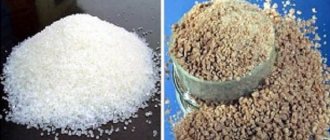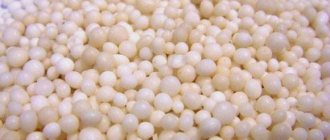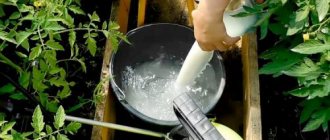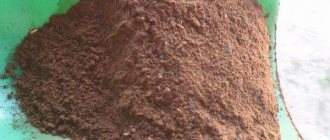Potassium monophosphate for tomato seedlings
This is one of the most concentrated phosphorus-potassium fertilizers. Contains 52% phosphorus and 34% potassium, it is completely soluble in water. Promotes strengthening of the root system, growth of buds and flowers in plants.
Tomatoes need potassium more than any other nutrient. The use of this fertilizer strengthens the skin, improves the taste and color of the fruit. Phosphorus promotes the development of the root system of plants. Check out the article - 12 ways to increase your tomato yield.
How to dilute potassium monophosphate for tomato seedlings
The drug is used in solutions that should be prepared in small quantities. Since it quickly loses its properties in liquid form. Dissolve the product in both warm and cold water.
To feed seedlings, use 7-10 g of the drug per 10 liters of water. The first feeding is at the moment of formation of 2-3 true leaves. Use 3-5 liters of fertilizer per 1 sq. meter.
Feeding tomatoes after picking with potassium monophosphate
2 weeks after picking the seedlings, a second feeding is carried out. With the formation of 5-6 leaves - the third, the composition of the drug is the same, quantity - 5-10 liters per 1 sq. meter. Water over damp soil.
What do tomatoes like?
Potassium fertilizers for tomatoes help accelerate metabolism, which has a good effect on fruit set and ripening. Feeding helps the plant survive spring temperature fluctuations and protects it from pathogens. Transplantation and rooting occurs faster. At the same time, other substances, nitrogen and phosphorus, must also be present in sufficient quantities.
Video: Expert advice on fertilizing tomatoes, including potash
The tomato bush feels good when the nutrition is balanced. To do this, you should follow the sequence of feeding:
- In the spring, before planting seedlings, you need to fertilize the soil with nitrogen so that the plants can gain green mass and be ready to set fruit.
- Towards the end of flowering, the most important moment comes - fertilizing with potassium mixtures. If time is lost, some part of the plants may shed flowers or ovaries. At this moment, you should watch the tomatoes especially carefully in order to notice the lack of substances in time. Gardeners usually water their plots every evening. There is time to take a closer look at the foliage - if it begins to change color, then urgent action must be taken. One foliar feeding is enough for the plant to come to life.
- In the fall, after harvesting, you need to restore the soil by digging it up with phosphorus and potassium. Fertilizers will dissolve over the winter, and in the spring it will be easy for plants to absorb nutrients.
There are different types of potash fertilizers, but not all of them are suitable for the type of soil. Knowing the characteristics of each type of mineral fertilizer, taking into account the composition of the soil - its pH, you can choose the optimal nutrition for plants (more on this in the section on types of potash fertilizers).
Feeding adult tomatoes
After planting the plants in a permanent place, apply potassium monophosphate to tomatoes 2 times with an interval of 2-3 weeks.
Root and foliar feeding of tomatoes is carried out in the open ground and in greenhouses.
How to dilute potassium monophosphate for tomatoes
The preparation of the solution depends on the form of the substance that is used.
When diluting the powder, you need to use distilled or boiled water. The granules can be diluted in any water.
How to water tomatoes at the root
For root feeding, use a solution of 15 g of the drug and 10 liters of water. In the greenhouse, treat the plants when the first ovaries appear. Use one bucket of liquid for 4 tomato bushes.
Useful articles:
- Application of Nitrophoska in the garden
- How to feed cucumbers for a good harvest
- How to use Potassium Sulfate as a fertilizer
Spraying tomatoes with potassium monophosphate
Apply foliar feeding with a 0.2% solution, i.e. Dissolve 2 g of the substance in 10 liters of water. Spray plants between main crop treatments.
Use 4-6 liters of fertilizer per 1 square. meter, for young bushes 2-3 liters for this area. Fertilizing stimulates flowering and the appearance of ovaries in plants. At the time of flowering, spray the tomatoes with a concentrated fertilizer solution. Dilute the product in a ratio of 1:10.
General rules for applying phosphorus
The main dose of phosphorus fertilizers is applied to the soil, preferably in the fall. In this case, they acquire the most accessible form for tomato roots. In greenhouses with constant soil replacement, fertilizers are applied 3-4 weeks before planting.
Fertilizers should not be scattered superficially, otherwise they will take on poorly soluble forms.
The granules must get into a constantly moist layer of soil at the level of future tomato roots. Therefore, they are first distributed over the surface, and then the ground is dug up.
Water-soluble fertilizers (superphosphates) are practically ineffective in acidic soils. In addition, tomatoes develop worse in them. At least a month before using such fertilizers, the soil is deoxidized. Add wood ash or lime. An alternative is to use bone meal or phosphate rock, which are effective in acidic environments.
It is impossible to overfeed tomatoes with phosphorus; they absorb only the required amount of the element. But you can’t indiscriminately add microelements to the soil. A large amount of phosphorus in the soil blocks the supply of important nutritional components to plants: iron, potassium, zinc, etc.
Optimal phosphorus synthesis in a plant occurs only when it is absorbed by the roots. Phosphorus absorbed by leaves moves very slowly and in small volumes to other organs. Accumulates in leaves. Maximum absorption reaches only 50% five days after spraying.
Plantings treated with the foliar method lag behind in development, the leaves gradually fall off. Therefore, phosphorus fertilizers for all cultivated plants are applied only at the roots.
In the video you can clearly see what the leaves of tomato seedlings look like when there is a lack of phosphate and learn about methods of fertilizing.
Advantages and disadvantages of feeding tomatoes
In their reviews, gardeners note a number of advantages of Potassium Monophosphate:
- the product is well absorbed by plants;
- increases productivity and product quality by increasing sugars and vitamins;
- improves frost resistance of crops and their resistance to diseases;
- the use of fertilizer will not harm the environment;
- good compatibility with other drugs;
- low impact on changes in soil acidity;
- increasing the shelf life of tomatoes as a result of using the product;
- Flowers develop additional stems with peduncles.
Disadvantages include:
- it is inadmissible to soak plant seeds in a solution, which will slow down the development of the crop;
- You should not prepare a mixture of fertilizer with nitrogen, calcium and magnesium for fertilizing;
- the product is hygroscopic and loses its properties when wet;
- Weeds are very fond of the drug;
- Fertilizer quickly disintegrates in the soil, so apply it only in solution.
Operating principle
The drug has many advantages. With its regular use, the following positive effects have been noted:
- at the budding stage, the number of flowers and fruits begins to increase;
- improvement of marketability and taste criteria of tomatoes;
- strengthening immunity against a large number of pathogens;
- increased resistance to frost;
- improved resistance to pests;
- increase in the volume of vegetative mass.
Phosphorus is important for photosynthesis and the growth of vegetative mass. If there is a lack of an element in the soil, the following is disrupted:
- bloom;
- set of green mass volume;
- fruit formation.
If you fertilize correctly, tomatoes will ripen earlier and the shoots will look green and fresh. Phosphorus is important for the formation of inflorescences and ovaries. If there is enough element in the soil, the roots will be well branched.
Potassium monophosphate has good solubility. Tomatoes quickly absorb fertilizer.
How to replace Potassium Monophosphate for tomatoes
This fertilizer differs from others in that the phosphorus contained in it is easily absorbed by garden crops. Other medications must be added a year in advance for this element to take effect.
Analog of Potassium Monophosphate – Pekacid
You can replace potassium monophosphate with superphosphate and potassium nitrate. But the only substance with a similar composition is Pekacid. But this fertilizer is more expensive than Potassium Monophosphate.
Composition of Pekacid:
- phosphorus – 60%;
- potassium – 20%
Combining phosphorus with other fertilizers
Almost always, several fertilizers are applied to the soil at once. To save time and effort, they are often mixed, calculating the required amount. But not every combination leads to the desired results.
What phosphate fertilizers should not be mixed with:
- superphosphates: with ammonium nitrate, synthetic urea, calcium nitrate, lime fertilizers, ash, ammonium sulfate, phosphate rock, phosphate slag;
- phosphate rock and bone meal: with superphosphates, superphosphate, lime fertilizers, calcium nitrate;
- precipitate: with lime fertilizers, ash, chalk, manure, chicken droppings;
- phosphate slags: with ammonium sulfate, ammophos, diammophos, nitrophos, ammonium nitrate, superphosphates, manure, droppings;
- complex fertilizers: with lime, ash, manure, chicken droppings.
Combining phosphorus with these fertilizers reduces its availability, and some mixtures form a dense and non-dispersible mass. In any case, before using the fertilizer, you should carefully study its characteristics in the instructions.
Before growing tomatoes, you need to find out all its requirements for mineral nutrition, apply exactly as much fertilizer as needed for the season. It’s even better to take a comprehensive approach, combining mineral and organic nutrition. But it is impossible to replenish all the minerals necessary for a culture with organic matter alone.
Reviews of potassium monophosphate
Vera, Nizhny Novgorod
I have been using monopotassium phosphate for tomatoes for many years and have not noticed any changes in the soil. I have a lot of flowers in the garden and I always feed them with this product. They grow bushy, bloom profusely and for a long time. One day I didn’t read the instructions and scattered the granules dry, and didn’t get the effect. I advise you not to forget to read the instructions for use.
Olga, Noginsk
I use a product to feed seedlings. The roots become strong by the time of planting, and the plants take root well. To avoid surprises, I do not mix monophosphate with nitrogen, although there are no contraindications. Every 2 weeks I water the plants with fertilizer because it is harmless. And its composition is optimal for plants.
Types of phosphate fertilizers
Phosphorus fertilizers are divided into quickly soluble and sparingly soluble. Complex ones are also used - with the combination of 2-3 elements and the addition of microelements.
Water soluble
The most easily digestible type of vegetable crops. Available for plants with soil acidity pH 6.2-7.5. Since tomatoes are grown mainly in acid-neutral soils, it is recommended to use this form.
Available in the form of granules and powder. The amount of the element in all fertilizers is measured in terms of phosphorus oxides (P2O5).
Kinds:
- superphosphate (phosphorus content in powder form is 19%, in granular form more than 20%, additionally contains sulfur 50%; main application: per 1 m² of cultivated soil 30-50 g, uncultivated - 60-70 g, for fertilizing: 1.5-3 g per 1 liter of water);
- double superphosphate (contains 43-49% phosphorus, does not contain sulfur, the characteristics are similar to superphosphate, when applying the dose is reduced by 2 times);
- superphos (phosphorus content 38-40%, superior to superphosphates in effectiveness and duration of action).
These fertilizers practically do not acidify the soil. They are applied to the soil before sowing seeds and used for additional fertilizing during the growing season.
Granules have a number of advantages over powder: they contain more phosphorus, do not cake during storage, and do not form insoluble compounds in the soil.
Lemon- and sparingly soluble fertilizers
The greatest effectiveness of these fertilizers is achieved in acidic soils. Use only for pre-sowing application. On acid-neutral soil, apply together with acidic fertilizers: all types of manure, ammonium sulfate, urea.
- Thomas slag, phosphate slag, defluorinated phosphate.
Contains phosphorus 20-30% in lemon-soluble form. They are applied only to the soil at a rate of 50-80 g per 1 m²; they are not suitable for fertilizing or local use.
- Precipitate.
This is calcium phosphate, contains 27-35% phosphorus. Available in powder form, does not cake and disperses well. Its effectiveness is not inferior to double superphosphate, and in acidic soils it has a longer action.
- Phosphorite flour.
There are 4 grades of phosphate rock with different phosphorus content: 30%, 25%, 22%, 19%. Phosphorus is available to plants only in acidic soils. The optimal rate is 300-500 g per 1 m² (depending on the level of soil acidification).
- Bone flour.
Phosphorus content 30-35%. Apply in a dose of 100-200 g per 1 m².
The phosphorus of all these fertilizers is absorbed by tomatoes after exposure to the acid of the earth, root secretions of plants and bacteria. Application in increased doses saturates the soil with the element for several years.
Complex fertilizing
These are complex fertilizers containing 2-3 or more elements. They are more concentrated, are distinguished by their uniform distribution on the soil surface and the availability of all elements for plants. Used for pre-sowing and local fertilizing.
Kinds:
- diammophos (contains 50% phosphorus, 18% nitrogen);
- ammophosphate (contains 44-46% phosphorus, 6% nitrogen);
- nitrophoska (contains phosphorus, potassium and nitrogen (NPK), elements can be in different proportions);
- potassium monophosphate (contains phosphorus 23% and potassium 28%);
- ammophos (contains 11% nitrogen, 50% phosphorus).
This is only a small part of complex fertilizers containing phosphorus. There are many types of fertilizers with different NPK ratios and with the addition of microelements. With time and experience, each gardener decides on his “own” type of fertilizer for tomatoes, selecting them based on the requirements of the crop in different phases of development.











